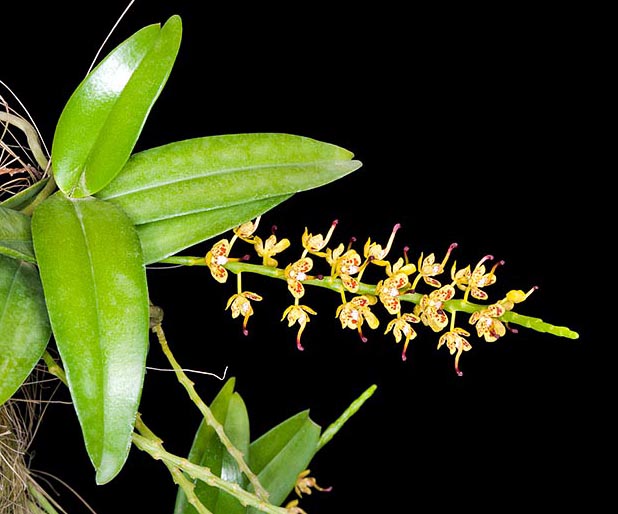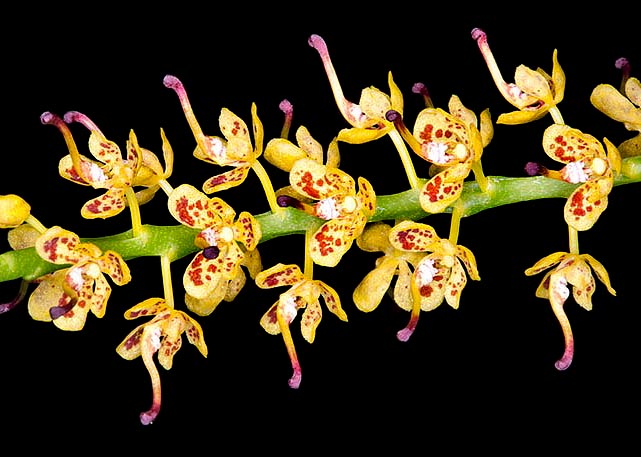Family : Orchidaceae

Text © Pietro Puccio

English translation by Mario Beltramini

Pteroceras teres is a nice epiphytic mini-orchid with 20 cm inflorescences © Giuseppe Mazza
The name of the genus is the combination of the Greek terms “pteron” = wing and “kéras” = horn, with reference to the appendix located at the apex of the labellum; the name of the species is the Latin term “teres” = round, name given by Blume to the Dendrocolla teres, basionym (synonym on which is based the name of the species), with reference to the cylindrical peduncle, as opposed to the Dendrocolla compressa, whose peduncle is flattened.
The Pteroceras teres (Blume) Holttum (1960) is a monopodial epiphytic species with thin stem carrying 4 to 14 alternate, oblong-linear, leaves, 4-10 cm long and 2-3 cm broad.
Lateral inflorescences, up to 20 cm long, hanging, carrying a variable number of short-lasting flowers, tiny, with a diameter of about 1 cm, with yellowish sepals and petals with brown dots and whitish trilobed labellum with purple dots presenting a callous apex having a dark purple colour. The sepals are elliptic-ovate, are 0,6 cm long and 0,4 cm broad, the obovate petals 0,5 cm long and 0,3 cm broad, the labellum is trilobed, 0,8 cm long, with a sort of a spur, hollow and bent at the apex of the median lobe. It reproduces by seed, in vitro.
Miniature orchid with slightly scented flowers and of relatively easy cultivation, it requires medium-high temperatures, with winter lowest of 12-14 °C, slight shade, high humidity, 60-80%, and constant air movement.

The about 1 cm flowers are scented. Relatively easy cultivation © Giuseppe Mazza
During the vegetative period the waterings must be regular and abundant, rather reduced in winter, allowing the compost to dry up, if in pot, before giving water again.
For the waterings and the nebulisations are to be utilized rainwater, or water obtained through reverse osmosis or demineralised; the fertilizations, duly distributed and alternated, in way to avoid salts accumulation at the roots, are to be done during the vegetative period preferably with balanced hydro-soluble products, with microelements, at ¼ of the dosage suggested on the package.
It can be mounted on bark, cork or arborescent ferns roots raft, or cultivated in pots or baskets, preferably suspended, with very draining and aerated compost, which may be formed by medium sliced bark fragments with possible addition of inerts in order to improve the drainage.
It does not love to be disturbed, therefore transplants, repottings and divisions are to be done only when strictly indispensable, and at the moment of the appearance of the new roots.
The species is reported in the appendix II of the CITES (species whose trade is internationally ruled).
Synonyms: Dendrocolla teres Blume (1825); Aerides suaveolens Roxb. (1832); Aerides teres (Blume) Lindl. (1833); Pteroceras radicans Hassk. (1842); Ornitharium striatulum Lindl. & Paxton (1851); Sarcochilus teres (Blume) Rchb.f. (1863); Thrixspermum teres (Blume) Rchb.f. (1868); Sarcochilus suaveolens (Roxb.) Hook.f. (1890); Sarcochilus palawanensis Ames (1915); Pteroceras suaveolens (Roxb.) Holttum (1960); Pteroceras teres (Blume) Bakh. f. (1963).
→ For general notions about ORCHIDACEAE please click here.
